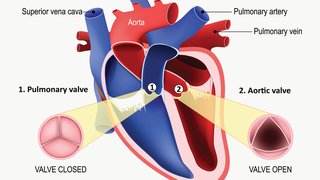
Atrial fibrillation (AFib) is the most common type of heart arrhythmia (irregular heartbeat), affecting as many as 6.1 million people in the U.S. In severe cases, AFib can lead to heart failure, stroke, and other serious conditions – but new trials recently published and presented show improved outcomes and lower rates of hospitalization for patients who undergo catheter ablation treatment.
AFib sometimes can be felt as a fluttering or “thumping” in the chest when the upper chambers of the heart beat out of sync with the lower chambers. However, some patients experience no symptoms, and their condition is detectable only by a doctor’s examination.
Two specific clinical trials – the Catheter Ablation versus Standard Conventional Therapy in Patients with Left Ventricular Dysfunction and Atrial Fibrillation (Castle AF Trial), which was published in 2017, and the Catheter Ablation versus Antiarrhythmic Drug Therapy in Atrial Fibrillation (CABANA trial), presented as a late breaking clinical trial in 2018, suggest that catheter ablation is proving to be effective in reducing symptoms including heart failure and mortality in AFib patients.
What is catheter ablation?
Catheter ablation is a procedure that can correct heart rhythm problems (arrhythmias) by using either heat or freezing to disrupt abnormal electrical signals in the heart tissue, thus preventing AFib. This procedure is typically used to treat AFib when it cannot be controlled by medicine.
The procedure is performed using long, flexible tubes (catheters) that are inserted through a vein in the groin and threaded to the heart to deliver the energy. In the past, catheter ablation was performed through open-heart surgery, but today’s catheter approach is less invasive which benefits patients with shorter recovery times.
"The Catheter Ablation versus Standard Conventional Therapy in Patients with Left Ventricular Dysfunction and Atrial Fibrillation (Castle AF Trial), which was published in 2017, and the Catheter Ablation versus Antiarrhythmic Drug Therapy in Atrial Fibrillation (CABANA trial) presented as a late breaking clinical trial in 2018, suggest that catheter ablation is proving to be effective in treating AFib patients."
– Mark Link, M.D.
What the trials say
CASTLE-AF
The CASTLE-AF trial randomly assigned 398 heart failure patients who had an implanted defibrillator with symptomatic paroxysmal or persistent AFib. The study’s patients previously had no response to antiarrhythmic drugs, had experienced unacceptable side effects, or were unwilling to take these drugs. They were randomized to receive either catheter ablation or medical therapy.
After following patients for three years, researchers found a lower rate of mortality from any cause in heart failure patients who received catheter ablation rather than medical therapy (13 percent vs. 25 percent). Hospitalizations for worsening heart failure were also reduced for those receiving catheter ablation. The composite of death from any cause or hospitalization for worsening heart failure, meanwhile, occurred at a significantly lower rate in the ablation group than in the medical therapy group (28.5 percent vs. 44.6 percent).
Data from the CASTLE-AF trial suggest that catheter ablation is preferable to antiarrhythmic drugs and provides benefits to select patients with a diagnosis of heart failure. Furthermore, the data also suggest that AFib patients need to be not too sick or their hearts need to be not too damaged to benefit from catheter ablation or to undergo the procedure safely.
CABANA
The CABANA trial is one of the largest electrophysiological trials in the past five years. From 2009 to 2016, 2,204 patients with new or untreated AFib were randomized to receive drug therapy or catheter ablation to compare the safety and efficacy of both therapies.
When randomized to receive drug therapy, patients were treated with standard medical care, including antiarrhythmic agents, if their doctor and they wished. Because patients and doctors knew to which treatment they were assigned, there were many patients who did not receive their assigned treatment. Approximately 28 percent of patients who were randomized to drug therapy ended up having an ablation, and about 9 percent of patients who were randomized to ablation did not undergo the procedure.
When the results were analyzed by randomized group, there was no difference. However, when analyzed by the treatment received, patients undergoing ablation had an improvement in outcomes. The full results in publication form are still awaited.
At UT Southwestern, our goal is to provide AFib patients with the most effective, up-to-date treatments possible to enhance their quality of life – a feat accomplished through state-of-the-art care coupled with continued research. We care for AFib patients at our high-volume heart center, providing them with the expertise they deserve.
Stay on top of health care news. Subscribe to our blog today.











